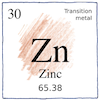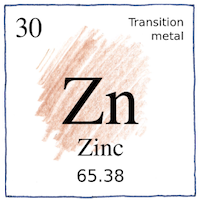Judea, India,
Nagarjuna
elements

|
Zinc
Zinc is found as a copper alloy in Judea. Mines in Rajasthan provided zinc ores. Conventional smelting didn’t work for zinc because the metal instantly oxidizes. Distillation of pure zinc was developed in Rajasthan by the twelfth century and described by Nagarjuna, the metallurgist and alchemist.
Atomic number 30
Zinc is a hard and brittle metal that burns with a bluish-green flame. Exposed to air, it forms a protective layer of zinc carbonate. * European chemists didn’t produce pure zinc until the 1700s. Alessandro Volta used plates of zinc and copper to make the first battery in 1799. * Zinc is essential for living organisms. Its deficiency results in diarrhea, skin problems, depression, stunted growth, and increased cases of pneumonia and malaria. Zinc in the diet increases one’s ability to experience happiness and pleasure. * Zinc carbonate and zinc gluconate are dietary supplements. Zinc chloride is a deodorant. Zinc sulfide is a white pigment but mixed with silver luminesces blue, mixed with manganese orange-red, and with copper glow-in-the-dark green.
Anhedonia
In the land of Anhedonia people are depressed. The world is sad and dreary; everyone is weary. In the land of Anhedonia there’s a scarcity of zinc. There’s nothing to do and pleasures are few. In the land of Anhedonia it’s pretty hard to think. From despair that nothing lessens we never learn our lessons.



A lack of hedonic tone is a symptom of zinc deficiency, as well as a variety of physical problems—thining hair, mouth sores, impaired immune function, and so forth. Consider zinc for yourself or your friends who would otherwise suffer or go to a doctor for antidepressants.
See also in The book of science:
Readings in wikipedia:
Other readings: